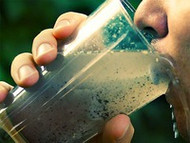Should I be concerned about lead in my water?
Posted by Collin West on Apr 8th 2016
What happened in flint, Michigan was/is an atrocity. A city supplying water to its residents that was unsafe.
What and why did it happen?
Improper water treatment caused irreparable damage to children by poisoning them with lead. How did this happen? Could you be at risk of the same danger? What solutions are there to avoid being poisoned without warning? In this small segment we will cover shortened answers that cover the essentials to these questions.
The Flint, Michigan water crisis started in April 2014. Flint changed its water source from treated Detroit Water and Sewerage Department water, sourced from Lake Huron as well as the Detroit River, to the Flint River. Officials failed to apply corrosion inhibitors into its drinking water which yield a series of problems that culminated with lead contamination, creating a serious public health danger. The corrosive Flint River water caused lead from aging pipes to leach into the water supply, causing extremely elevated levels of the heavy metal. In Flint, between 6,000 and 12,000 children have been exposed to drinking water with high levels of lead and they may experience a range of serious health problems. The really sad part is that the problem was known and officials voted against returning to Detroit water and asked for emergency money instead to try and fix the problem. The water was in violation of the EPA Safe drinking water requirements for THMs and continued leaching lead for its aging infrastructure while poising the people of Flint. The term “My child was poisoned by policy” arose while lawsuits and resignations loomed. There is much more to chew on in this story, but for now, we will end with Flint is not the only city with such issues.
Could you be at risk of poor water being delivered to while being called safe?
First
thing to take into careful consideration is the age of the city and home you
live in. Lead in our pipes wasn’t addressed until 1986. Section 1417 of the Safe Drinking Water Act (SDWA)
establishes the definition for “lead free” as a weighted average of 0.25% lead
calculated across the wetted surfaces of a pipe, pipe fitting, plumbing
fitting, and fixture and 0.2% lead for solder and flux. The Act also
provides a methodology for calculating the weighted average of wetted surfaces.
The Act prohibits the “use of any pipe, any pipe or plumbing fitting or fixture, any solder, or any flux, after June 1986, in the installation or repair of any public water system; or any plumbing in a residential or non-residential facility providing water for human consumption, that is not lead free.”
What this means is that if your home or the building was built prior to 1986, there should be some concern. You can check with your city to updates on piping for clarity. Constant growths often requires upgrades to old infrastructure, but if there is money to be saved, it will be.
Boil warnings and constant flushing of water mains/hydrants are good indicators that an issue is out there and it may be time to start asking questions. Rapid growth in America has also resulted in us using aquifers, previously thought to never be needed. Underground waste dumping may be coming back to haunt us and unregulated chemicals are becoming more and more prevalent in our drinking water. Simple answer to the question is yes. There are a lot of variables that could result in poor drinking water being labeled safe and delivered directly to us. Is another Flint just around the corner? Odds are yes.
What solutions are out there?

There are a wide range of options for water purification. Specialized components are applied to water known to have specific problems such as Flint. The best way to protect from such situations is to know what is currently listed and tested for and finding the proper media to remove it. Counter top pitchers often times only remove taste and odor from water and leave the chemicals behind. Be diligent in choosing the right water filter for the right job. Make sure to use a product or a company that can answer questions about percentage of toxins removed. Ask questions and speak with somebody who understands you and your family’s needs so that you aren’t getting inadequate results. Much like Flint, saving money up front make cost you dearly in the end. Get the right tool for the right job and you should be safe from “policy!”
Check out:
Ultra fine drinking water solutions
REMEMBER TO ASK A LOT OF QUESTIONS!
Be well informed. You don't need to know everything. You just need to know somebody who does.



